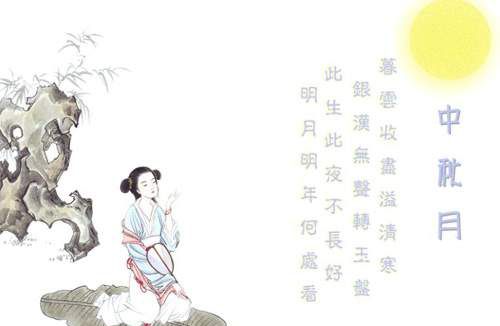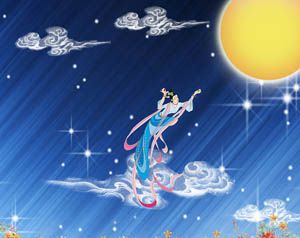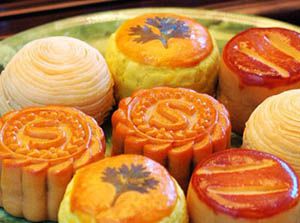Mid-Autumn Festival 中秋节双语介绍

The Mid-Autumn Festival (zhōng qiū jié 中秋节), also known as the Moon Festival, is a popular harvest festival celebrated by Chinese people and Vietnamese (yuè nán rén 越南人) people (even though they celebrate it differently), dating back over 3,000 years to moon worship in China's Shang Dynasty (shāng cháo 商朝).It was first called Zhongqiu Jie in Zhou Dynasty (zhōy cháo 周朝). In Malaysia (mǎ lái xī yà 马来西亚) and Singapore (xīn jiā pō 新加坡), it is also sometimes referred to as the Lantern Festival or Mooncake Festival.
Legend about Mid-Autumn Festival
It is said that the earth once had ten suns circling over it, each taking turn to illuminate the earth. One day, however, all ten suns appeared  together, scorching the earth with their heat. Houyi (hòu yì 后羿), a strong and tyrannical archer, saved the earth by shooting down nine of the suns. He eventually became King, but grew to become a despot (bào jūn 暴君).
together, scorching the earth with their heat. Houyi (hòu yì 后羿), a strong and tyrannical archer, saved the earth by shooting down nine of the suns. He eventually became King, but grew to become a despot (bào jūn 暴君).
One day, Houyi stole the elixir (xiān dān 仙丹) from a goddess. However, his beautiful wife, Chang'e (cháng é 嫦娥), drank it so as to save the people from her husband’s tyrannical rule. After drinking it, she found herself floating, and flew to the moon. Houyi loved his divinely beautiful wife so much, he did not shoot down the moon. Chang'e flew to the moon grabbing a rabbit to keep her company. So the Chinese say that if you look up at the moon to this day you can sometimes see a rabbit making moon cakes.
Customs in Mid-Autumn Festival
The Mid-Autumn Festival is held on the 15th day of the eighth month in the Chinese calendar, which is usually around mid or late September in the Gregorian calendar. It is a date that parallels the autumn and spring equinoxes (chūn fēn 春分) of the solar calendar, when the moon is supposedly at its fullest and roundest. The traditional food of this festival is the mooncake, of which there are many different varieties. The Mid-Autumn Festival is one of the two most important holidays in Chinese calendar, the other being the Chinese New Year, and is a legal holiday in several countries. Farmers celebrate the end of the summer harvest season on this day. Traditionally, on Mid-Autumn Day, Chinese family members and friends will get together to admire the bright mid-autumn harvest moon, and eat moon cakes (yuè bǐng 月饼) and pomeloes (yòu zi 柚子) together. Accompanying the celebration, there are additional cultural or regional customs, such as eating moon cakes outside under the moon, carrying brightly lit lanterns, lighting lanterns on towers, floating sky lanterns, burning incense (fén xiāng 焚香) in reverence to deities including Chang'e, planting Mid-Autumn trees (shù zhōng qiū 树中秋), collecting dandelion leaves and distributing them evenly among family members and Fire Dragon Dances (wǔ huǒ lóng 舞火龙).
The Mid-Autumn Festival is one of the two most important holidays in Chinese calendar, the other being the Chinese New Year, and is a legal holiday in several countries. Farmers celebrate the end of the summer harvest season on this day. Traditionally, on Mid-Autumn Day, Chinese family members and friends will get together to admire the bright mid-autumn harvest moon, and eat moon cakes (yuè bǐng 月饼) and pomeloes (yòu zi 柚子) together. Accompanying the celebration, there are additional cultural or regional customs, such as eating moon cakes outside under the moon, carrying brightly lit lanterns, lighting lanterns on towers, floating sky lanterns, burning incense (fén xiāng 焚香) in reverence to deities including Chang'e, planting Mid-Autumn trees (shù zhōng qiū 树中秋), collecting dandelion leaves and distributing them evenly among family members and Fire Dragon Dances (wǔ huǒ lóng 舞火龙).
中秋节
农历八月十五是中国重要的传统节日——中秋节。 每年农历八月十五日,是传统的中秋佳节。这时是一年秋季的中期,所以被称为中秋。在中国的农历里,一年分为四季,每季又分为孟、仲、季三个部分,因而中秋也称仲秋。八月十五的月亮比其他几个月的满月更圆,更明亮,所以又叫做“月夕”,“八月节”。此夜,人们仰望天空如玉如盘的朗朗明月,自然会期盼家人团聚。远在他乡的游子,也借此寄托自己对故乡和亲人的思念之情。所以,中秋又称“团圆节”。
相传,远古时候天上有十日同时出现,晒得庄稼枯死,民不聊生,一个名叫后羿的英雄,力大无穷,他同情受苦的百姓,登上昆仑山顶,运足神力,拉开神弓,一气射下九个多太阳,并严令最后一个太阳按时起落,为民造福。后羿因此受到百姓的尊敬和爱戴,后羿娶了个美丽善良的妻子,名叫嫦娥。后羿除传艺狩猎外,终日和妻子在一起,人们都羡慕这对郎才女貌的恩爱夫妻。不少志士慕名前来投师学艺,心术不正的蓬蒙也混了进来。
一天,后羿到昆仑山访友求道,巧遇由此经过的王母娘娘,便向王母求得一包不死药。据说,服下此药,能即刻升天成仙。然而,后羿舍不得撇下妻子,只好暂时把不死药交给嫦娥珍藏。嫦娥将药藏进梳妆台的百宝匣里,不料被小人蓬蒙看见了,他想偷吃不死药自己成仙。三天后,后羿率众徒外出狩猎,心怀鬼胎的蓬蒙假装生病,留了下来。待后羿率众人走后不久,蓬蒙手持宝剑闯入内宅后院,威逼嫦娥交出不死药。嫦娥知道自己不是蓬蒙的对手,危急之时她当机立断,转身打开百宝匣,拿出不死药一口吞了下去。嫦娥吞下药,身子立时飘离地面、冲出窗口,向天上飞去。由于嫦娥牵挂着丈夫,便飞落到离人间最近的月亮上成了仙。
傍晚,后羿回到家,侍女们哭诉了白天发生的事。后羿既惊又怒,抽剑去杀恶徒,蓬蒙早逃走了,后羿气得捶胸顿足,悲痛欲绝,仰望着夜空呼唤爱妻的名字,这时他惊奇地发现,今天的月亮格外皎洁明亮,而且有个晃动的身影酷似嫦娥。他拼命朝月亮追去,可是他追三步,月亮退三步,他退三步,月亮进三步,无论怎样也追不到跟前。后羿无可奈何,又思念妻子,只好派人到嫦娥喜爱的后花园里,摆上香案,放上她平时最爱吃的蜜食鲜果,遥祭在月宫里眷恋着自己的嫦娥。百姓们闻知嫦娥奔月成仙的消息后,纷纷在月下摆设香案,向善良的嫦娥祈求吉祥平安。从此,中秋节拜月的风俗在民间传开了。
我国人民在古代就有“秋暮夕月”的习俗。夕月,即祭拜月神。到了周代,每逢中秋夜都要举行迎寒和祭月。设大香案,摆上月饼、西瓜、苹果、红枣、李子、葡萄等祭品。
在唐代,中秋赏月、玩月颇为盛行。在北宋京师。八月十五夜,满城人家,不论贫富老小,都要穿上成人的衣服,焚香拜月说出心愿,祈求月亮神的保佑。南宋,民间以月饼相赠,取团圆之义。有些地方还有舞草龙,砌宝塔等活动。明清以来,中秋节的风俗更加盛行;许多地方形成了烧斗香、树中秋、点塔灯、放天灯、走月亮、舞火龙等特殊风俗。